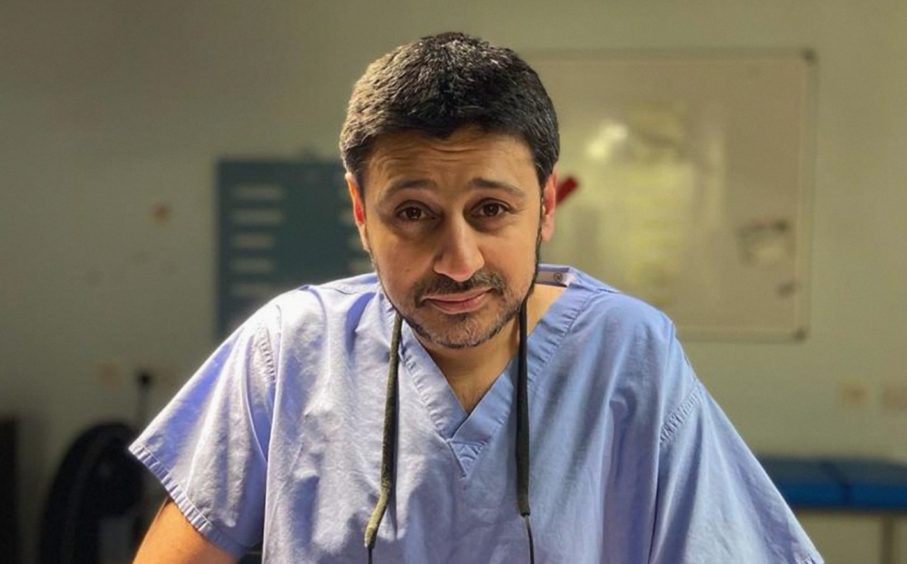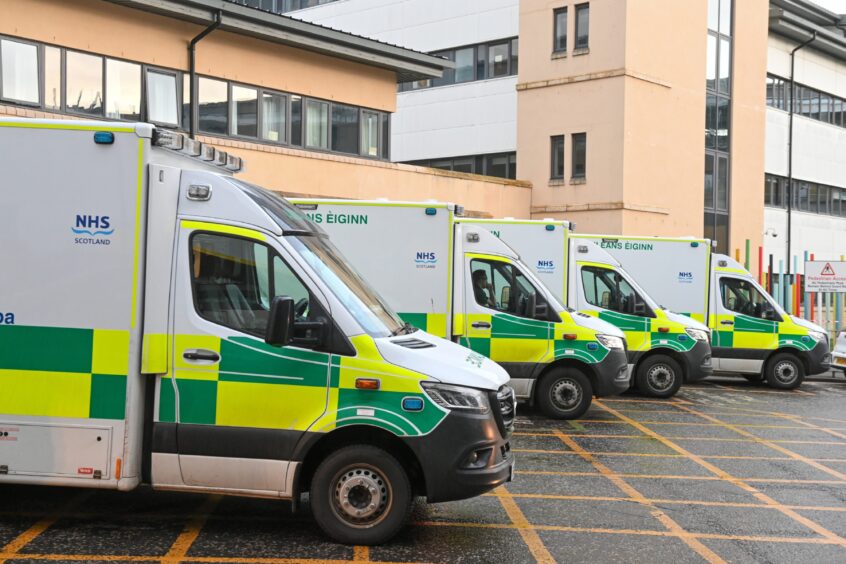
A catalogue of worrying incidents involving unregulated medics who are being used to replace doctors and nurses has been revealed in a new survey.
The physician associates (PAs) have been found to be involved in a number of serious events in Scotland, including missing a brain haemorrhage.
The survey of 680 UK doctors on patient safety was carried out by the Doctors Association UK (DAUK) and, among its findings, revealed a PA conducted an inappropriate examination on an unresponsive patient that delayed other staff providing critical airway support to keep the person breathing.
DAUK says these two incidents were revealed in feedback from doctors working alongside PAs in NHS Lothian.
It was told – but has so far been unable to confirm – about a PA working in a large Scottish hospital who persuaded a newly qualified doctor to prescribe the wrong medication.
Meanwhile, in Aberdeen, a pager that was supposed to be held by a consultant-level stroke specialist was instead being carried by a PA.
Physician associates
PAs – bioscience graduates usually with two years’ medical training – undertake work that was once the preserve of fully-qualified doctors. DAUK is run by frontline doctors and campaigns both for doctors and the wider NHS.
Dr Matt Kneale, an A&E doctor and co-chair of DAUK, said: “The clinical safety incidents reported in Scotland were particularly alarming. Both the missed subarachnoid haemorrhage and the inappropriate examination took place in NHS Lothian. We were able to confirm and verify that these occurred through checking the source.
“Elsewhere, we also received a report of a critical incident in which a PA transcribed a prescription chart and got a first-year junior doctor in training to sign it. PAs are not authorised to sign or issue prescriptions. This led to a significant drug error for the patient.
“These reported clinical safety incidents provide a detailed look into the practical implications of integrating PAs into the NHS.”
Prescription for trouble? Warning over increasing use of unregulated medics
The DAUK survey also reports incidents where PAs are overreaching their scope of practice and representing themselves as the equivalent of higher medical roles like registrars or senior house officers.
It adds that this is happening in high-pressure areas like A&E departments and surgical clinics.
Kneale added: “The most at-risk locations identified in Scotland were Edinburgh Royal Infirmary and Aberdeen Royal Infirmary, with significant concerns regarding the integration of PAs, role clarity, impact on medical training and patient safety. We had one report at Aberdeen that suggested a PA has held the consultant bleep in the stroke speciality.”
The report also uncovered instances of PAs introducing themselves vaguely to patients leading to confusion about their NHS roles and qualifications. Unlike doctors or nurses, PAs are not regulated by governing bodies like the General Medical Council (GMC)and Nursing and Midwifery Council (NMC). They are supervised by their health board or GP employers.
The GMC says there are about 3,000 PAs and 180 anaesthetic assistants in the UK, with numbers expected to grow. The GMC plans to regulate PAs this year.
Medical blunders
The Sunday Post last month reported that there were at least 12 Never Events – which are classed as serious blunders – linked to PAs in Scottish hospitals. The details were gained in Freedom of Information requests sent to Scottish health boards. NHS Grampian reported as having had none.
The two-pronged DAUK examination of PAs is currently focused not only on medical blunders but the undermining of the medical profession by using them to replace doctors. It says it has serious concerns over the GMC regulating them and that confusion over PAs’ responsibilities arise when they are told they are doctors, after their two-year university training.
“The feedback we have from PAs who went on to graduate from further university medical degrees to become doctors, is they were given an inappropriate and misguided level of confidence in their PA training,” said Kneale. “They were told as PAs they were doctors after they completed their two-year PA degree.”
He added that many doctors were concerned over the lack of consultation with the public over the introduction of PAs to the NHS. He said: “There is evidence of confusion among patients over who they are and what they do, and what they not permitted to do.”
Surgeon demands urgent review after ‘mishaps’ caused by unregulated medics
Transplant surgeon Dr Zubir Ahmed, an NHS consultant who works in a large teaching hospital and is a prospective Westminster Labour candidate for the Glasgow South West constituency, called for an urgent review of PAs.
He said: “These latest reports contribute to an expanding portfolio of concerns regarding the expanding role of PAs.
“When used appropriately PAs can have benefits for patient care and for medical training. However, their rollout by both UK and Scottish governments appears to be following a model of subjecting the public to medicine on the hoof without regulation or consent.
“We urgently need a public and professional consultation on what is appropriate for PAs to do and, more importantly, not to do.”
Plugging the gaps
PAs have been introduced into the NHS to plug the gaps caused by governments failing to recruit enough medical students and retain them by not offering enough postgraduate higher training places vital to reach consultant or specialists.
About 5,000 doctors apply to the GMC every year to emigrate, some seeking higher training places and others who say they can no longer cope with the stress of working in the NHS.
Tracey Gillies, Medical Director at NHS Lothian said: “Our Physician Associates work under the supervision of a fully trained doctor, as part of multi-disciplinary teams. Using established clinical guidelines, in conjunction with the clinical teams and in line with nationally agreed protocols and guidance, they provide high-quality, safe and effective clinical and emergency care.
“Significant adverse events are reviewed by our clinical teams to support improvements to care and our systems or processes. All level one adverse events are reported to HIS (Healthcare Improvement Scotland) on a monthly basis.
“NHS Lothian has robust policies and procedures in place to ensure all staff are supported and feel able to raise concerns and we actively encourage staff to highlight issues relating to patient safety. If staff have concerns, we urge them to speak to their line manager in the first instance.”
NHS Grampian said: “While we cannot comment on these specific allegations, speaking generally, any incident of patient harm should be recorded and investigated. We have a wide range of avenues available for staff to raise concerns about any aspect of their duties, or the duties of others.
“PAs are a vital and valued part of our team, working alongside a range of other clinical colleagues to provide high quality patient care.”
The Scottish Government said: “Physician associates are an important and valued part of the NHS Scotland workforce. Legislation is currently with both the Scottish and UK parliaments to bring this role into statutory regulation by the General Medical Council.
“This will introduce personal accountability to an independent regulator, establishing for the first time UK-wide professional standards for education, practice and behaviours underpinned by meaningful consequences when these are not met.”
70% report a negative impact from using PAs
Training Physician Associates (PAs) is reducing time for getting junior surgeons up to speed, a leading doctors’ organisation warned.
A report by the Association of Surgeons in Training (ASiT) says 70% of all who replied to a survey of members reported a negative impact from PAs.
ASiT say it was the largest survey they had conducted in the organisation’s 48-year history.
More than 38% said there was a strongly negative effect.
The problem is caused by senior surgeons, including consultants and other senior specialists, having to devote time to training PAs.
The report adds that, while 87% agreed that PAs provided support with efficiency in the ward, only 23% believed they increased training opportunities in the operating theatre.
Scottish transplant surgeon Dr Zubir Ahmed, an NHS consultant who works in a large teaching hospital and is a prospective Westminster Labour candidate for the Glasgow South West constituency, called for an urgent review of the PA system within the health service.
He said: “These latest reports contribute to an expanding portfolio of concerns regarding the expanding role of PAs.
“When used appropriately PAs can have benefits for patient care and for medical training.
“However, their rollout by both UK and Scottish governments appears to be following a model of subjecting the public to medicine on the hoof without regulation or consent.
“We urgently need a public and professional consultation on what is appropriate for PAs to do and more importantly not to do.”
A doctor working in rural Scotland, who did not want to be named, said: “What the report tells us that several surgeons feel PAs are effectively stealing learning opportunities
“Consultants in training, who are the surgeons we need for tomorrow as experienced surgeons and trainers for the next generation of junior surgeons, are being left out in the cold.
“Tomorrow’s surgeons are losing out to unregulated PAs.”
The ASiT study reports that impact on patients means fewer going through theatre.
More than 70% of surgeons reported this – with almost 80% saying PAs decreased training opportunities in theatre.
MSP calls for action as study reveals 1,600 scots may have died because of long accident and emergency waits
More than 1,600 Scots may have died unnecessarily last year as a result of long waits at A&E departments, it has been claimed.
Official statistics show 117,741 patients waited more than eight hours for emergency treatment in Scotland in 2023.
The Royal College of Emergency Medicine estimates one excess death for every 72 patients who spend 8-12 hours in an emergency department. The rate is based on a study of more than five million NHS patients.
Based on the number of patients in Scotland since the start of 2023 who waited more than eight hours, there has been an estimated 1,635 excess deaths.
In 2022, a staggering 142,000 people waited more than eight hours in Scotland’s emergency departments, potentially resulting in almost 2,000 excess deaths.
Scottish Labour health spokeswoman Jackie Baillie called on SNP Health Secretary Michael Matheson to take urgent action to avoid further needless loss of life.
She said: “1,600 excess deaths – this is the human cost of the SNP’s incompetent running of our NHS. These are not mere numbers – these are vulnerable people in need who have been failed by this SNP Government. Hard-working staff are being pushed to breaking point.
“We need action now to tackle delayed discharge, support primary care and to invest in our NHS workforce.”
In October, the Royal College of Emergency Medicine (RCEM) warned the number of people waiting 24 hours or more in A&E was 250 times higher than in 2019.
Figures obtained through Freedom of Information requests showed 3,949 patients spent a day or more in A&E in the six months up to June. That compared with 15 patients during the same period in 2019.
Official figures show it was unusual for patients to endure extremely long waits in A&E before 2020, with only a handful waiting more than 24 hours between 2013 and 2018.
But the numbers began to increase dramatically later in 2021, and then, in 2022, almost 7,000 patients waited at least 24 hours to be admitted, transferred or discharged.
Dr John-Paul Loughrey, vice-president of the RCEM, described those waiting times as appalling, adding it was distressing for vulnerable elderly patients and those facing a mental-health crisis.
He said there were no plans to increase the number of beds in hospitals and no measures to retain staff, who were facing burnout and exhaustion.
Waiting times performance improved sharply in the week leading up to Christmas Eve, with Public Health Scotland reporting 65.1% of people attending emergency departments were seen within the official four-hour target.
This was up from 61.6% the previous week, and the best figure since mid-October. However, it was well short of the target for 95% of patients to be admitted, transferred or discharged within four hours. It has not been met nationally since July 2020.
The worst-performing health board in the week before Christmas was NHS Forth Valley, with 41.8% of patients seen within four hours, then NHS Lothian (59.6%) and NHS Greater Glasgow and Clyde (60.7%).
A Scottish Government spokesperson said: “While A&E performance in Scotland is not where it needs to be, it continues to be the best performing in the UK for eight years.
“We’ve always recognised the relationship between long waits in A&E and increased risk of harm, which is why we remain committed to delivering improved A&E performance. A&E departments across the UK continue to experience pressures – this is not unique to Scotland. However, we continue to work closely with boards to reduce the number of long delays – including the expansion of Hospital at Home services and implementation of the Delayed Discharge and Hospital Occupancy Action Plan.”

Enjoy the convenience of having The Sunday Post delivered as a digital ePaper straight to your smartphone, tablet or computer.
Subscribe for only £5.49 a month and enjoy all the benefits of the printed paper as a digital replica.
Subscribe
 © DC Thomson
© DC Thomson